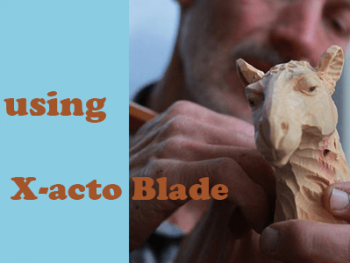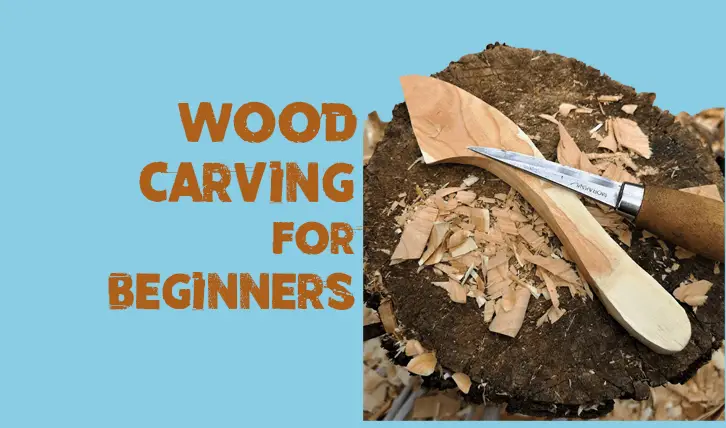Without the proper know-how, many beginners and even intermediates may find the craft of wood carving technical and challenging. It can also be difficult to find information on what to do and where to begin, which is why We’ve put together this wood carving as a beginner’s guide.
In just 8 steps, you’ll learn the fundamentals of woodcarving, whether you’re a beginner or an intermediate looking to sharpen your skills.
First, let’s go over the basic principles of wood carving and the various types of carving. Before we even consider picking up our chisels, we should first identify with at least one style.
Wood Carving for Beginners – Main types of carving
Wood Carving is a form of sculpting where the artist cuts away at wood to expose patterns and textures. It can be done in many ways, from Whittling (cutting shapes with an edged tool) to Chip Carving (cutting images out using pointed chisels). The technique was originally used for decoration or clothing. But has since evolved into many other categories, such as furniture making.
– Whittling:
Whittling often concentrates on creating three-dimensional forms like animals. It can also be on objects that are carved all the way around rather than just flat faces. Whittle carvers generally use knives made specifically for this activity.
This is because they need more control than what you would find in your typical kitchen knife set. We recommend this as the best wood carving for beginners as it’s easy to learn and its projects are not as time-consuming as some of the other types of carving.
– Chip Carving:
This method is one of the most common forms of wood carvings, which involves taking a chisel and cutting out shapes in an image. Chip tools are typically pointed so they can create finer details than their flat counterparts. While this is still a good form of wood carving for beginners, the difficulty may vary from project to project.
Some projects may be very massive, requiring a lot of time to complete. However, this should not discourage beginners as they can still enjoy small projects that can be completed over the weekend. Check out our article on ideal chip carving project ideas for beginner carvers.
– Relief Carving:
Relief carving creates designs by removing background sections rather than adding new material like some other sculpting techniques. This technique has been used for centuries. And is popular because it’s great for creating three-dimensional pieces. Pieces have depth without plaster or clay, filling in all the gaps between carved lines.
– Carving In The Round:
This technique involves sculpting an object from all sides, which means you have to know what it will look like before you start carving because there’s no turning back once you’ve started! The difficulty with this method is getting those curves just right so they don’t look warped out of shape – but when executed properly, the result can be stunning.
Look at some vital wood carving tools you need to get started on that next-level wood curving DIY.
Now that we know what wood carving is and have a style in mind and an assortment of awesome tools, let’s dive right in on the eight easy steps!
Wood Carving for beginners in 8 easy steps
Step One:
The first step is to find the best wood for carving. A few different types of wood work well, but one of my personal favorites is basswood. Basswood has been used in many projects because it’s soft and easy to carve into any shape you want! It also holds detail very well compared with other woods like pine or hardwoods such as oak or walnut.
Step Two:
Find a good whittling knife/craft blade. Many people say there are specific knives made just for carving. But these can be expensive and not necessary unless you’re planning on doing this professionally (which we hope isn’t going to!) Instead, use an all-purpose craft blade or any of the sets I recommended above.
Step Three:
Choose a project to work on. This can be as simple or as complicated as you want it to be. Nonetheless, before getting started, ensure your knife will easily cut into the wood without risking injury. For example, suppose I wanted to carve a small block of pine (something many people would consider beginner level). In that case, my blade might not cut all the way through because pine is softer than basswood and other hardwoods mentioned above- so try something else instead! Hang around we’ll talk about what makes up for some good projects for beginners!
Step Four:
Now that you have chosen a project, think about whether or not you want to hand-draw your design before starting. Some people (myself included) can’t see what they’re trying to carve until it’s on the wood because they start carving too soon! I recommend drawing out your idea in pencil and then using this as a reference when cutting into the wood with your blade so you don’t go off track. If this doesn’t work for you, there are many other options, such as tracing an image onto paper and then transferring it over later without doing any of the actual carvings yourself!
Step Five:
Once we’ve drawn our design onto our piece of basswood, it’s time to start carving! Make sure you have a good grip on your knife and are seated comfortably. Cutting into the wood too fast or too hard can cause injury, so carve slowly but firmly with even pressure until it goes through to the other side (or at least deep enough that it will be impossible for you to cut all the way through).
Step Six:
After completing our first few cuts, it’s time to start shaping different curves and lines using an X-acto blade, as pictured below.
These blades are designed specifically for this purpose and work well when working on smaller projects like these! Be careful not to go too far down while cutting because if something such as paint gets onto your new blade, then it may become ruined. You’ll have to buy a new one (sudden expenses are never fun!).
Step Seven:
Once we’ve shaped out the basic shape of our piece, it’s time for some finer details. You can either use an X-acto blade again or switch to your whittling knife if you’re more comfortable with that. One thing I always find helpful is making sure my workspace stays clean so there’s less risk of accidentally cutting into something other than wood!
Step Eight:
The final step is sanding down your project to make it smooth before painting/staining/sealing depending on what type of finish you want at the end. This can be done by hand using just sandpaper. Alternatively, you can invest in a power tool like the one pictured below to save yourself some time. The last thing we want is an unfinished project because it’s beautiful and special!
Here are some articles with tips on polishing your carved project
Should You Stain or Seal your Wood?
The best way of finishing a wood carving project
Conclusion on wood carving for beginners
In summary, there’s nothing too difficult about wood carving projects, but they can be very rewarding. The projects in this blog post range from simple to more complicated, so there is something for everyone!
That’s all, folks! I hope these tips helped teach you some of the basics of carving wood. We didn’t have time to cover so many other ways. However, if you’re looking for something quick and easy when trying DIY projects- carving is always fun!
Tips & Tricks from our experts: When picking up a new blade, ALWAYS make sure they feel comfortable in your hand and never use them without proper instruction (especially if they are dull!). Safety first, people!

